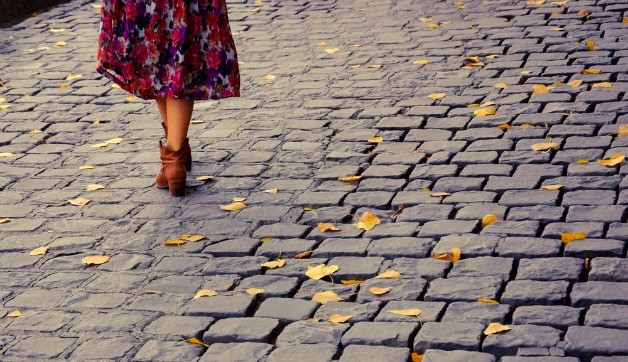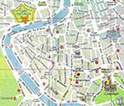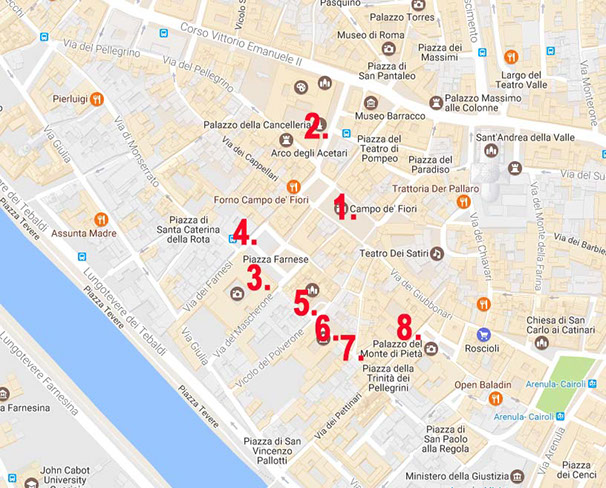Walk 1.
The Campo dei Fiori and surrounds.
An easy 30 minute walk.
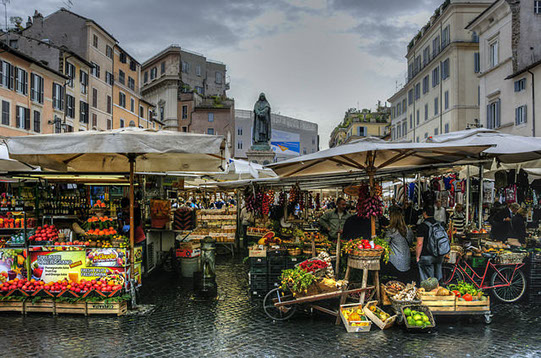 1. Start in the Campo dei Fiori, at the feet of the statue of Giordano Bruno, burned at the stake here in 1600, having been found guilty of heresy for supporting such outrageous (to us, at least) things as supporting Galileo’s view that the earth circled the sun.
1. Start in the Campo dei Fiori, at the feet of the statue of Giordano Bruno, burned at the stake here in 1600, having been found guilty of heresy for supporting such outrageous (to us, at least) things as supporting Galileo’s view that the earth circled the sun.
 While the campo today has succumbed to the tourist trade with kitch pasta and tat, it still has remnants of its past, and with a little effort you can imagine the market as it has operated here for centuries. The surrounding bars and restaurants aren't all that bad and are still worthwhile spots for people watching. Every afternoon a small army of cleaners descend on the campo and clear all the rubbish and remains of the market, leaving a wonderful open piazza that soon fills with couples on their evening passagiata, buskers looking for a few euro and those looking for a drink and a fun night out.
While the campo today has succumbed to the tourist trade with kitch pasta and tat, it still has remnants of its past, and with a little effort you can imagine the market as it has operated here for centuries. The surrounding bars and restaurants aren't all that bad and are still worthwhile spots for people watching. Every afternoon a small army of cleaners descend on the campo and clear all the rubbish and remains of the market, leaving a wonderful open piazza that soon fills with couples on their evening passagiata, buskers looking for a few euro and those looking for a drink and a fun night out.
Behind you, in the far right corner as you look away from Bruno, is one of the best deli's in Rome, Ruggeri.
Leading out from next to that is the Via Giubbonari, a good shopping street.
But to commence our walk, start under Bruno's feet and walk directly ahead, through the various market stalls (if you are there in the morning) and to the far left corner of the Campo, behind the flower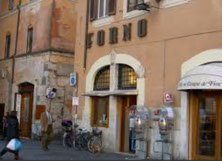 sellers, to the small lane running directly out of the campo. This is Via Capellari (street of the hat makers) where on both sides of the corner you will find one of the best forno (bakery) in Rome. Provision yourself with an ‘Ungherasi’ or a piece of pizza. In the 16th. century the smaller of the two forno was the "Taverna della Vacca" (The Cow's Tavern).
sellers, to the small lane running directly out of the campo. This is Via Capellari (street of the hat makers) where on both sides of the corner you will find one of the best forno (bakery) in Rome. Provision yourself with an ‘Ungherasi’ or a piece of pizza. In the 16th. century the smaller of the two forno was the "Taverna della Vacca" (The Cow's Tavern).
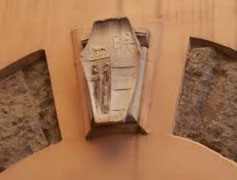 The tavern was operated in the 1520's by Vannozza Caetani, the mistress of Pope Alexander VI and mother of the infamous poisoner, Lucrezia Borgia. You can still see her coat of arms on the building facade above the forno.
The tavern was operated in the 1520's by Vannozza Caetani, the mistress of Pope Alexander VI and mother of the infamous poisoner, Lucrezia Borgia. You can still see her coat of arms on the building facade above the forno.
No real need to venture up the via Cappellari... it is now mostly run down apartments with the occasional interesting shop, but turn to the right and go past the "La Carbonara", walking about 100 metres. over to the Piazza Cancelleria.
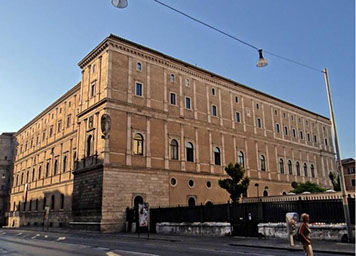 2. The Palazzo Cancelleria, or 'The Papal Chancellery', is regarded as the first Renaissance palace built in Rome. It was designed by Donato Bramante (1444-1544) as a palace for Cardinal Raffaele Riario, who was a cardinal to his uncle, Pope Pius IV. The rumor was that the funds came in a single night's winnings at gaming. The palazzo is an extraterritorial property of the Holy See and is designated as a World Heritage Site.
2. The Palazzo Cancelleria, or 'The Papal Chancellery', is regarded as the first Renaissance palace built in Rome. It was designed by Donato Bramante (1444-1544) as a palace for Cardinal Raffaele Riario, who was a cardinal to his uncle, Pope Pius IV. The rumor was that the funds came in a single night's winnings at gaming. The palazzo is an extraterritorial property of the Holy See and is designated as a World Heritage Site.
Inside the courtyard you can see columns scavenged from the ancient Roman Theatre of Pompey. The forty-four Egyptian granite columns are from the porticoes of the theater's upper covered seating, however they were originally taken from the theatre to build the old Basilica of St. Lorenzo.
In the palazzo is a vast mural that Giorgio Vasari completed in a mere 100 days (therefore called Sala dei Cento Giorni). He boasted of this accomplishment to Michelangelo, who responded "Si vede" ("It shows"). In the palazzo a little private theatre was installed by Cardinal Pietro Ottoboni and in the later 17th.C. the Cancelleria became a center of the musical life of Rome. Today the Chancellery houses an exhibition of machines built from Michelangelo’s plans and drawings.
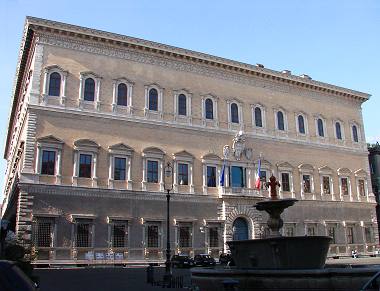 3. Retrace your steps back to the Campo and continue directly along the Vicolo del Gallo (past the forno again ... perhaps another Ungherasi?). You will emerge after 100 metres into the Palazzo Farnese, the most magnificent Renaissance palace in Rome and now home to the French Embassy. Admire the roof cornice and grand entrance by Michaelangelo.
3. Retrace your steps back to the Campo and continue directly along the Vicolo del Gallo (past the forno again ... perhaps another Ungherasi?). You will emerge after 100 metres into the Palazzo Farnese, the most magnificent Renaissance palace in Rome and now home to the French Embassy. Admire the roof cornice and grand entrance by Michaelangelo.
If you are starting to feel the strain of the journey, relax for a moment and take a coffee at the Café Farnese. The outside tables offer a good view of the Palazzo and the two fountains in the square, originally from the Roman baths of Caracalla.
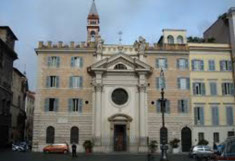 4. On the right side of the square is the church and Convent of St. Brigida, home to Swedish nuns that also offers reasonable but austere accommodation.
4. On the right side of the square is the church and Convent of St. Brigida, home to Swedish nuns that also offers reasonable but austere accommodation.
Once refreshed, continue diagonally across the piazza to the left, then along the narrow Vicolo dei Venti. All along and around you are medieval houses in various states of repair.
5. You first come to a small square... the Piazza della Quercia, that was once graced by a lovely Oak tree (Quercia), now sadly gone. The building at the back of the square is the home of the Fraternity of Butchers. The restaurant "La Quercia" is quite good, with a speciality of tripe for those so inclined.
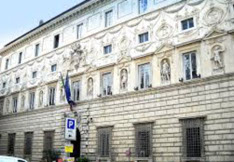 6. Continue straight and into the Via Capo de Ferro. Here is the Palazzo Spada, built in 1540 for Cardinal Girolamo Capodiferro, then bought in 1632 by Cardinal Spada who commissioned the architect Borromini to refurbish the building. The palace, with its facade and courtyard of sculptures crowded into niches with fruit and flower swags, grotesques and symbolic vignettes, contains an interesting gallery of sculpture and paintings.
6. Continue straight and into the Via Capo de Ferro. Here is the Palazzo Spada, built in 1540 for Cardinal Girolamo Capodiferro, then bought in 1632 by Cardinal Spada who commissioned the architect Borromini to refurbish the building. The palace, with its facade and courtyard of sculptures crowded into niches with fruit and flower swags, grotesques and symbolic vignettes, contains an interesting gallery of sculpture and paintings.
The stand-out however, is the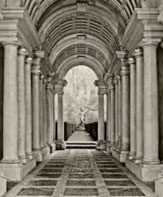 Borromini Perspective, a masterpiece of forced perspective optical illusion in which diminishing rows of columns and a rising floor create the visual illusion of a gallery 37 metres long (it is only 8 metres) with a life-size sculpture at the end. The sculpture is actually only 60 cm high. You can see the perspective from the courtyard, just walk through the main doors and look like you are heading to the gallery entrance, though if you would like to see the perspective up close, guides will take you inside (for a small fee, of course).
Borromini Perspective, a masterpiece of forced perspective optical illusion in which diminishing rows of columns and a rising floor create the visual illusion of a gallery 37 metres long (it is only 8 metres) with a life-size sculpture at the end. The sculpture is actually only 60 cm high. You can see the perspective from the courtyard, just walk through the main doors and look like you are heading to the gallery entrance, though if you would like to see the perspective up close, guides will take you inside (for a small fee, of course).
7. Continue along Via Capo dei Ferro. Just before the next intersection with Via de Pettinari, note how the building on the left, itself medieval, uses columns salvaged from earlier ruins.
Look right along Via dei Pettinari and you can see in the distance the Ponte Sisto, a pedestrian bridge over to Trastevere. Half way along the via is a good supermarket.
However turn left onto the Via Pettinari. 100 metres along brings you to the Via dell'Arco dei Monte, (with the arch bridging the street). There is a fabulous Sicilian pasticeria here on the left. You MUST try the 'Nipples of Venus', though it is probably better if you ask for them as Capezzoli di Venere.
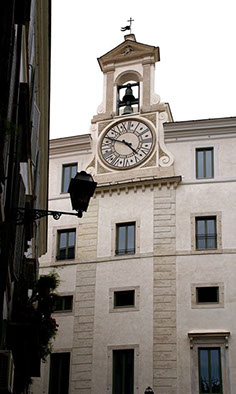 8. The square to the right is the Piazza Monte di Pieta or Pawnshop, and it was here, in the building with the clocktower, that pawnshops were established by the church in the 1500's, lending money without interest to poor people on a pledge.
8. The square to the right is the Piazza Monte di Pieta or Pawnshop, and it was here, in the building with the clocktower, that pawnshops were established by the church in the 1500's, lending money without interest to poor people on a pledge.
Admire the clockface by Borromini. It is thought that Caravaggio once took rooms in this building.
Continue on to join the Via Giubbonari, a busy shopping street that, on turning left, will take you back to the Campo dei Fiori where we started.
